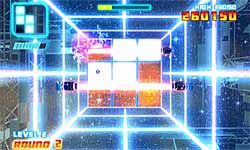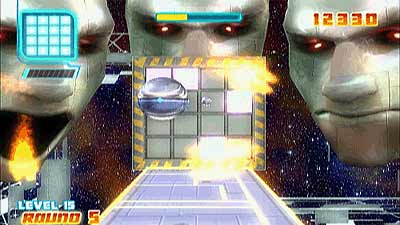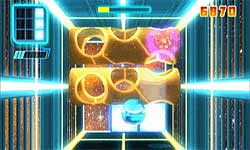Out of all game genres, puzzle games seem to contain the most potential for addiction. It’s one thing to go through an adventure game or an RPG after unlocking new modes of play. But puzzle games, if they’re designed well enough, get a hold on people that’s not easily broken-which speaks a lot to the typically simple to learn, not-so-simple to master game design so often seen in them. All the best puzzlers are famous for a certain kind of beckoning, teasing challenge that baits you into believing you can quickly become a master of its various rules and regulations (and even loopholes); that’s what keeps you playing. But not all puzzle games are created equal.

Unfortunately, Virtual Toys’ SpaceBall: Revolution falls short of reaching its full potential. The game works well enough as a momentary distraction, but there just isn’t enough of interest to keep all but the most diehard puzzle fans playing for more than a few rounds. That’s a pity, because the game design is promising at its core. Essentially, SpaceBall is played on a square grid of tiles that light up when you throw a spaceball (which looks and sounds a lot like a dodgeball, except silvery and metallic) at them. In the top left corner of the screen there’s a box with a lighted pattern displayed in it, and it’s your job to recreate the pattern on the grid. Think of lighting up squares to create Tetris pieces and you have the general idea.
The Wii-mote’s on-screen pointer is used to aim your spaceball’s shot, with one hit lighting up a square on the grid and another to turn it off. Trick shots can also be employed by aiming the pointer at the grid lines, which can either activate two adjacent squares or a grid of four squares when hitting a line or intersection, respectively. Furthermore, each pattern challenge that’s displayed is timed, and if you fail to complete it before the time runs out, the screen pulls back (a finite number of times, at that), effectively obscuring your vision and making it harder to aim precision shots (of which the game requires quite a bit).
At first, things are easy. You have a three by nine grid to work with. You can rack up combos without difficulty by using as few balls as possible to complete patterns. Multipliers are also easily racked up for hitting your intended target on the grid. For now, everything’s aces-but of course things don’t stay this simple for long. Like many puzzlers, the challenge in SpaceBall comes from obstacles, and boy, are there a lot of ’em.

They start out in relatively mundane forms: moving cubes that circle the grid and can block your shot and other simple obstructions. Then they get trickier. The cubes become stationary, floating above the certain squares of the grid. In order to get under them, you have to aim your ball at the sides of the arena where the grid lies, angling your shot so that the ricochet hits the square tile underneath the cube. Then the barriers get bigger. They start rotating. They come in larger and smaller sizes and come in odd, oblong shapes. They even start to move higher and lower in the arena, turning into rings and strange blocks reminiscent of the colored ones you might have played with as a kid. They get holes in them and become invisible and multiply and do all kinds of ridiculous things as the levels mount. Before the game is over, the entire grid will periodically rotate and even launch its own balls. And you have to contend with all of this while the timer for each pattern challenge ticks down. That’s all well and good.
But, aside from the near constant change-ups of what’s potentially blocking your pattern-finishing shot (or shots), there’s little that changes over the course of SpaceBall’s 15 levels. After playing for awhile, I started wondering when the level grids would expand to an area larger than three by nine; although this eventually did happen, the change took more time than I would have imagined, and it remains one of the few sources of variety seen in the game’s mechanics, outside of the mercurial nature of the game’s obstruction design.

As it stands, each level gives you five rounds with about ten pattern assembly challenges for each. Obstacles rear their ugly heads, make things difficult or stressful, the round ends, the next begins, and then the level is over. There are no power-ups (in a confusing contradiction to multiplayer, which does have them) to, say, destroy some of the obstacles, slow down time or fire off a volley of pre-targeted balls, and the combo multipliers are all but impossible to keep going because of the egregious nature of some of the barrier objects you have to contend with (which only count for points anyway).

Because of this lack of new mechanics, the entire structure of the game becomes tedious very quickly. Obstacles are much less an interesting challenge to navigate than they are flat-out annoying, which makes creating patterns under increasingly tight time limits an exercise in stress and annoyance rather than any kind of competitive enjoyment. The bonus level breaks aren’t much better, either. A bunch of metallic discs dart, float, and shoot across the sky as you shoot them. It won’t keep your interest for long.
SpaceBall does manage to do a few things right, however. Virtual Toys really nail a good outer space aesthetic rife with meteors, exploding colors, and the like (and done up in surprisingly good graphics for a WiiWare title), and the techno soundtrack is both catchy and very well done (almost as good as the chiptunes in the Bit.Trip series). Multiplayer is also fun, if only for a few minutes. Finally, there are more level packs that the dev team is planning to release as DLC in the future-whether or not they have any new tricks (besides different obstacles) remains to be seen. For now, approach this one with caution.
RATING OUT OF 5 RATING DESCRIPTION 4.0 Graphics
Virtual Toys took time to make SpaceBall’s outer space environs look stellar. 4.3 Control
The Wii-mote pointer action is pretty spot-on. Aiming your ball might be a little too sensitive from time to time. 4.0 Music / Sound FX / Voice Acting
The electronic techno soundtrack is actually a reason to play. The sound effects aren’t bad, either. You may get tired of hearing the announcer’s Eastern European-sounding accent, however. 2.5
Play Value
SpaceBall’s simple mechanics might be fun at first, but they quickly grow tedious as little changes from level to level. Two-player multiplayer helps, and there are online leaderboards if you’re interested.
3.0 Overall Rating – Fair
Not an average. See Rating legend above for a final score breakdown.
Game Features:
